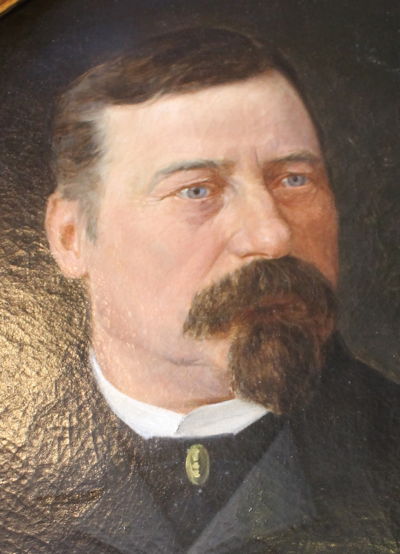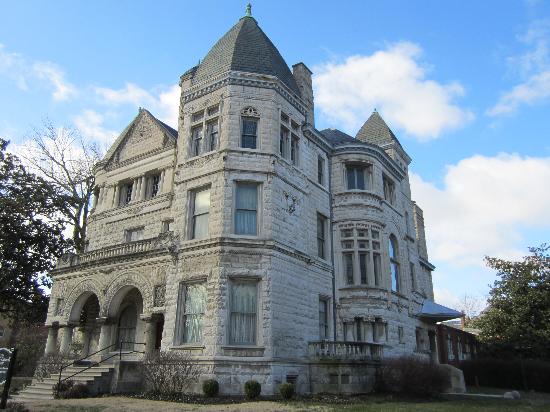
The following article by David Strange was originally published on 16 Oct 2016.

Theophile Conrad was born on August 6, 1832 in Strasbourg, France. Don't you just love that name? "Theophile"; I might just name my next child Theophile. But since I am 63 years old, I don't really plan on needing to make that decision again.
Theophile Conrad, the only child of Martine and Caroline Conrad, grew up in France. By 1851 he was planning a career in business and studying the methods of tanning. Now this is not tanning like actor George Hamilton made famous, with his perfect tans. It is a process to make raw animal skin into leather.
Tanning animal hide makes a leather that is more durable and less susceptible from decomposition. It can be a malodorous process, because of all the animal remains and because the skins are sometimes "putrefied" for up to several months as part of the process. Oak "tan bark," which provide the tannin chemical needed for curing, is used to treat the leather, giving the material its oaken color.
Bullitt County was a natural place for tanneries in the early days of Kentuckiana because of its forests of oak, and especially because of its natural resources of salt. Tanning involves the liberal application of salt to a freshly cleaned skin. Three to five pounds of salt might be used in the treatment of one deer or sheep skin. Bullitt County's salt-water springs provided the only source of salt in the region. Lots of fresh water was also needed, so most tanneries would be established near a good creek. Such creeks also provided a convenient way to get rid of animal remains, which often created terrible, foul-smelling pollution downstream.
Because of political unrest in France, Theophile and some friends emigrated to America in late 1853, enduring a stormy three-month passage to New Orleans where he planned to settle. But upon arriving at New Orleans, they found that the city was being ravaged by yellow fever. So they traveled on up river to Shippingport in Louisville, Kentucky, eventually settling in Shepherdsville in Bullitt County. While in Shepherdsville, he and August Fabel established a small tannery.
Tanneries, or "tan yards," were fairly common in the 1800's. In Bullitt County, I know of at least three besides Mr. Conrad's. Henry Kalfus had a large tannery located "just above the Methodist Church" in Shepherdsville in 1897. Gottfried Wolfe had one in Mt. Washington in 1880. The Bullitt County Manufacturing Company was started by James M. and W. H. Doom in 1850, tanning around 3,000 skins a year and making leather goods, with wages averaging $100 per month. In 1861, that company was incorporated by James F. Gamble, Robert Taliafero, and Robert B. Hopkins. There was also a tannery in northern Bullitt County near where the very nice modern-day residential subdivision of Tanyard Springs now exists.
And so, Theophile Conrad established his tannery, creating quite a good reputation for himself. Founding a larger tannery in Jefferson County, just north of Bullitt, he moved there by 1870, having several children with his wife, Maria Krieger Conrad.

Theophile was involved in numerous businesses, including the American Oak Leather Company, the Conrad Shoe Company, and the Conrad Kamerer Company of New Albany, Indiana. He organized the Third National Bank of Louisville and helped organize the first Humane Society for the Prevention of Cruelty to Animals. He was also a trustee of the First Unitarian Church and a Captain of the Home Guard in Louisville during the Civil War, which might explain his move to Louisville around that time. In 1897, Theophile built "The St. James," a five-story block of flats on St. James Court in Louisville (the top two stories were removed after a fire in 1912). One of the finest homes built on St. James Court was an opulent limestone mansion designed for him circa 1893 by Arthur Loomis. That mansion is known today as the Conrad-Caldwell House Museum.
Theophile was considered an authority on leather and tanning. In 1871, he received the Lorillard Gold Medal from the American Institute in New York. In 1873, he received the Emperor of Austria and King of Hungary Francis Joseph medal in Vienna. In 1876, he received a medal at the International Exhibition in Philadelphia.
Theophile Conrad died on February 13, 1905. He was buried at Cave Hill Cemetery in Louisville, survived by his wife Maria Krieger Conrad, four daughters, and seven grandchildren. Maria passed away on May 30, 1914.
My thanks go to Bullitt County History Museum researchers Lynn Eddington and Bob Cline for passing along much of this information to me. Excerpts are drawn from the biography of Theophile Conrad in "A Sesquicentennial History of Kentucky, 1945" and from "The Encyclopedia of Louisville." Information about the fabulous Conrad-Caldwell House Museum can be found on the web at https://conrad-caldwell.org/.
Copyright 2016 by David Strange, Shepherdsville KY. All rights are reserved. No part of the content of this page may be included in any format in any place without the written permission of the copyright holder.
The Bullitt County History Museum, a service of the Bullitt County Genealogical Society, is located in the county courthouse at 300 South Buckman Street (Highway 61) in Shepherdsville, Kentucky. The museum, along with its research room, is open 10 a.m. to 4 p.m. Monday through Friday. Saturday appointments are available by calling 502-921-0161 during our regular weekday hours. Admission is free. The museum, as part of the Bullitt County Genealogical Society, is a 501(c)3 tax exempt organization and is classified as a 509(a)2 public charity. Contributions and bequests are deductible under section 2055, 2106, or 2522 of the Internal Revenue Code. Page last modified: 12 Sep 2024 . Page URL: bullittcountyhistory.org/memories/conrad.html